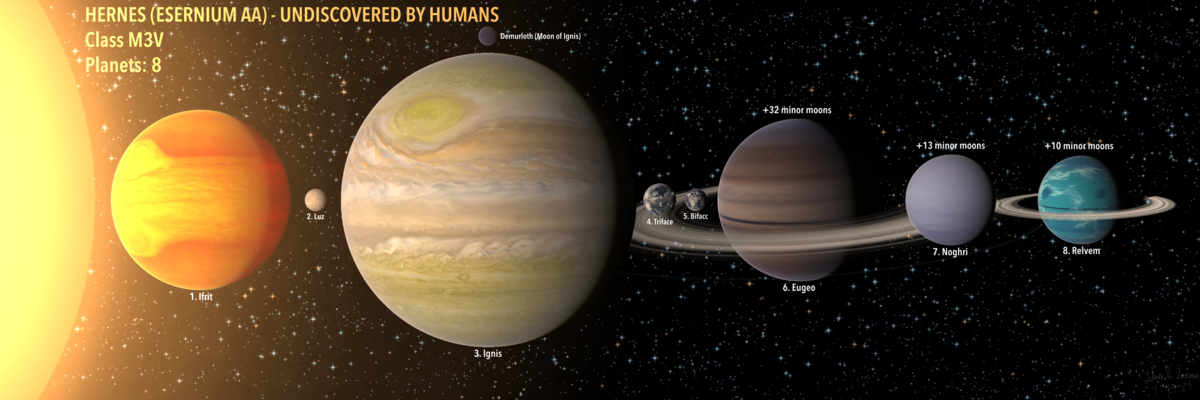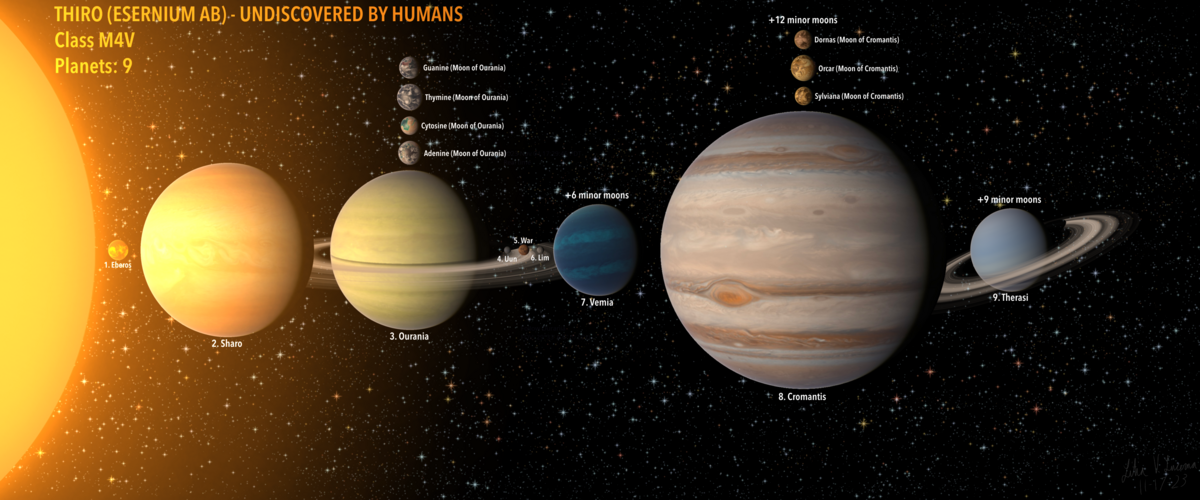Esernium System
 | |
| Age | ~12.5 billion years |
|---|---|
| Location | Orion Arm, Milky Way Galaxy |
| Nearest star | Proma (4.1 ly) |
| Nearest known planetary system | Proma system (4.1 ly) |
| Planetary system | |
| Semi-major axis of outer known planet |
Hernes: 3.8 AU (Relvem) Thiro: 1.96 AU (Theras) Gallentis: 2.15 AU (Supernididus) Bellantis: 0.94 AU (Sareth) |
Populations | |
| Known stars | 4 (Hernes, Thiro, Gallentis, Bellantis) |
| Known planets |
Hernes: 8 (3 terrestrial planets, 5 gas giants) Thiro: 9 (4 terrestrial planets, 5 gas giants) Gallentis: 7 (5 terrestrial planets, 3 gas giants) Bellantis: 6 (3 terrestrial planets, 3 gas giants) |
| Known dwarf planets | 13 (known) |
| Star-related properties | |
| Spectral type |
Hernes: M3V Thiro: M4V Gallentis: M5V Bellantis: M5V |
The Esernium System is a quadruple star system located 32.5 light-years from the Sun and roughly 9 light-years from the Ingffhaestian System. The system's four stellar components - Hernes, Thiro, Gallentis, and Bellantis - are all red dwarf stars near the hydrogen burning mass limit. Due to their relative dimness, the Esernium System's four stars were never discovered by the human race. At roughly 12.5 billion years old, Esernium is among the oldest star systems known; because of its relatively advanced age, its stellar components are relatively stable and experience fewer stellar flares and drastic brightness changes than other red dwarf stars of similar masses.
Esernium is structured into a pair of binaries, with Hernes and Thiro making up one binary system and Gallentis and Bellantis constituting another binary system. These binaries appear to be gravitationally bound to each other. All four stars bear planets; Thiro boasts the largest planetary system in Esernium at 9 planets, followed by Hernes at 8 planets, Gallentis at 7, and Bellantis at 6. Because of the tightly-pact nature of all four systems as red dwarf systems, the planets themselves tend to have lower masses; despite this, a majority of Esernium's planets are giant planets, albeit on the lower end mass-wise.
Though Esernium never developed native life, the Kingdom of Kerolon heavily subjected the system to colonization by Ingffhaestian lifeforms, such as tabulons, throughout the 19th to 21st centuries CE (10th to 12th centuries a.r.k.) due to the valuable resources offered by the system's plentiful planets. Within just a few years, Esernium grew into one of Kerolon's most populous and developed interstellar colonies, with the quadruple star system receiving a steady and high influx of residents and both on-planet and orbital colonies advancing at an impressive rate; the system's ten habitable worlds - Triface, Bifacc, Adenine, Thymine, Cytosine, Guanine, Schmidt, Ralis, Jela, and Frostia - were renowned as the "Ten Colonies of Esernium", one of the most appealing places of residence in Kerolon outside of the Ingffhaestian System. At its peak, Esernium harbored a population of 86 billion, roughly an eighth of Kerolon's total population at the time.
The Esernium System was the location of the 6th of the 12 Great Calamities related to the fall of the Uingffhian interstellar nations. In late 2033, as part of its attempted genocide on non-tabulon sentients (itself the 4th chronological calamity) and war with the Great Morbidian Hegemony (the 5th calamity) under the presidency of Sentar Reisantis Kragrathea, the Unified States of Osuwa attempted to destroy the Morbidia-controlled Corvallis System - the home system of the People's Democratic Republic of Hydrasia - using their newly-built Amphicoelias superweapon. However, amidst a skirmish with armed rebel groups including Urlum Eudae Kerolon's Ark of Destruction, the Amphicoelias inadvertently fired upon Esernium instead. The Amphicoelias's lasers struck all of Esernium's planets without warning, killing over 99% of the system's 86 billion inhabitants and sterilizing all ten habitable worlds in the system. This event proved to be the catalyst for the Kingdom of Kerolon's subsequent entrance into the First Interstellar War and its unveiling of the Polyhex-Class World Breaker.
Composition
The Esernium System’s four stars - Hernes, Thiro, Gallentis, and Bellantis - form the primary gravitational components of the system. Because the four bear similar masses to one another, none of them dominate the system gravitationally, and they all share roughly equal influence over Esernium.
All four component planetary systems bear structures drastically different from the Solar System’s, with inner system giant planets and outer system terrestrial planets both being common sights in Esernium. However, all four systems' stars make up the vast majority of their respective solar systems' total masses and are mostly composed of hydrogen and helium like most stars. All four systems also display lower amounts of minor bodies like asteroids, comets, and dwarf planets due to their gravitational relationships and tightly-packed nature rendering most large-scale belts unstable in the long-term.
Hernes
Thiro
Gallentis
Bellantis
Orbits
WIP



